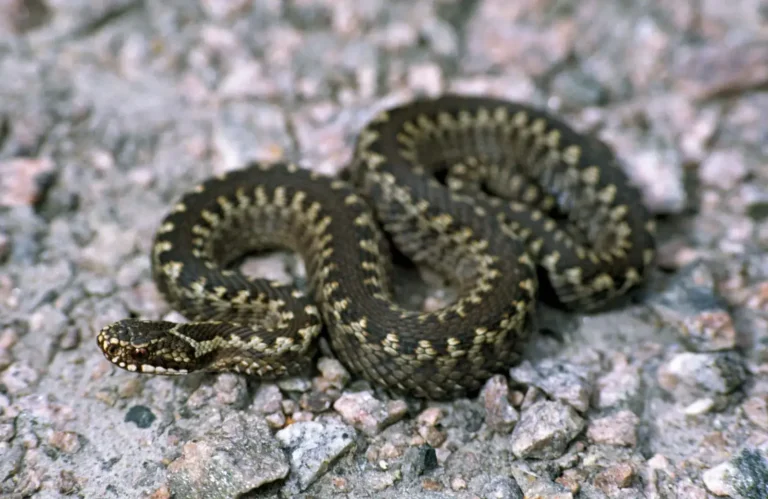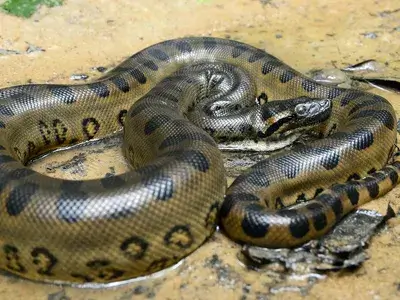Yellow Anaconda (Eunectes notes): A Detailed Overview
The Yellow Anaconda (Eunectes notaeus), a powerful semi-aquatic constrictor, is a fascinating reptile known for its impressive strength and striking yellow-greenish coloration. Though not as famous as its relative, the green anaconda, this snake plays a vital role in its ecosystem and has intrigued humans for centuries. This article explores its scientific classification, physical traits, habitat, behavior, diet, reproduction, etc.
Contents
Scientific Classification
- Kingdom: Animalia
- Phylum: Chordata
- Class: Reptilia
- Order: Squamata
- Family: Boidae
- Genus: Eunectes
- Species: Eunectes notaeus
The Yellow Anaconda belongs to the Boidae family, including other large constrictors like the green and boa constrictors.
Physical Characteristics

- Size: Females can grow up to 10-14 feet (3-4.5 meters), while males are typically smaller, reaching around 6-8 feet (1.8-2.4 meters).
- Weight: Females can weigh over 55 kilograms (121 lbs), with males being significantly lighter.
- Coloration: Their body is usually yellow or greenish-yellow with dark brown blotches or stripes that run across the body. This pattern helps them blend into their wetland habitats.
- Body Shape: Like other anacondas, they have a muscular, thick body and are known for their robust girth compared to snakes of similar length.
These physical traits make the Yellow Anaconda an apex predator in its environment, particularly in aquatic ecosystems where it uses its strength to overpower prey.
Habitat
The Yellow Anaconda is native to South America, specifically in countries such as:
- Argentina
- Paraguay
- Bolivia
- Brazil
They prefer swamps, marshes, slow-moving rivers, and other wetland areas. These environments provide the snake with the perfect conditions for hunting and concealment. As an aquatic species, it spends a significant amount of time submerged, often using water as a cover to ambush prey.
Behavior
- Solitary Lifestyle: Yellow Anacondas are solitary and territorial creatures like most snakes.
- Aquatic Nature: They are excellent swimmers who spend much of their time in or near water.
- Ambush Predator: Yellow Anacondas are ambush predators, meaning they lie in wait for their prey to come close before launching a quick strike.
- Thermoregulation: Being cold-blooded reptiles, they often bask in the sun to regulate their body temperature.
The Yellow Anaconda is typically more active during the twilight hours, using the cover of dusk or dawn to hunt.
Diet
Yellow Anacondas are carnivorous, feeding on a diverse range of prey, including:
- Fish
- Birds
- Mammals (such as capybaras and rodents)
- Reptiles (such as caimans)
Their constricting abilities allow them to subdue large prey, which they swallow whole. Younger anacondas may rely more on smaller animals, such as amphibians or small fish, as they become more formidable hunters.
Reproduction
Yellow Anacondas are ovoviviparous, meaning the females give birth to live young rather than laying eggs. Key reproductive characteristics include:
- Mating Season: Occurs during the cooler, dry season (typically April to June).
- Gestation Period: Around 6 months.
- Litter Size: Females can give birth to 10-40 live young at a time.
- Size of Newborns: The hatchlings are typically around 60-80 cm long and are independent from birth.
Females typically grow larger than males, which gives them an advantage in producing more offspring. Males will engage in mating battles during the season to secure breeding rights.
Predators and Threats
Due to their size and power, adult Yellow Anacondas have few natural predators. However, juvenile anacondas face more threats from larger predators, including:
- Jaguars
- Caimans
- Large Birds of Prey (e.g., Harpy Eagles)
Human activity is also a significant threat. Habitat destruction, poaching for their skins, and illegal pet trade contribute to the declining numbers of this species in the wild.
Conservation Status
While the Yellow Anaconda is not listed as endangered by the International Union for Conservation of Nature (IUCN), it faces significant risks from:
- Habitat Loss due to the expansion of agriculture and urban development.
- Exploitation for the skin trade and illegal wildlife trade.
In many areas, they are killed out of fear, as they are often mistakenly believed to be highly dangerous to humans. Efforts to protect their wetlands and educate local populations about their importance in the ecosystem are crucial to their survival.
Interesting Facts
- Semi-Aquatic Lifestyle: Yellow Anacondas can hold their breath for extended periods while submerged, making them expert ambush predators.
- Mythological Connection: Anacondas have long been featured in South American myths, often depicted as mythical serpents of great power.
- Shed Skin: Like all snakes, Yellow Anacondas shed their skin regularly, a process known as ecdysis.
- Role in the Ecosystem: Yellow Anacondas help control populations of other species, maintaining a balanced ecosystem, particularly in their aquatic environments.
Evolutionary History
Anacondas are believed to have evolved millions of years ago from ancient boid snakes. Over time, they adapted to aquatic environments, with the Yellow Anaconda being one of the smaller species in the genus Eunectes. Like the Green Anaconda, their close relatives demonstrate similar evolutionary adaptations, such as their powerful musculature and ability to thrive in water and on land.
Relationship with Humans
While Yellow Anacondas are not considered a direct threat to humans, they are often feared due to their size and strength. In rural communities, these snakes are sometimes killed on sight, even though attacks on humans are extremely rare. However, they are regarded with respect and caution in some areas, owing to their important role in controlling pest populations like rodents.
Conservation efforts that involve educating people about the non-aggressive nature of Yellow Anacondas and their ecological value are crucial. In recent years, ecotourism has also fostered appreciation for these reptiles in their natural habitats.
Conclusion
The Yellow Anaconda (Eunectes notaeus) is a fascinating and formidable species that thrives in the wetlands of South America. As a powerful predator, it plays a key role in its ecosystem, controlling the populations of various aquatic and terrestrial species. Although feared and misunderstood by many, this snake is a vital part of the natural world and deserves conservation efforts to protect it from the growing threats it faces. By preserving their habitats and fostering an understanding of their role in the ecosystem, we can ensure that the Yellow Anaconda continues to thrive for generations to come.
- Are Rottweilers Good With Kids? Reasons & Training Tips - 17 September 2025
- How Long Are Dogs Pregnant: Complete Guide - 16 September 2025
- German Shepherd Doberman Mix: Info, Pictures, Care & More - 11 September 2025






